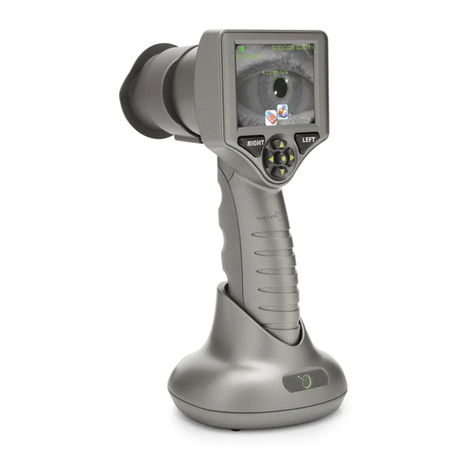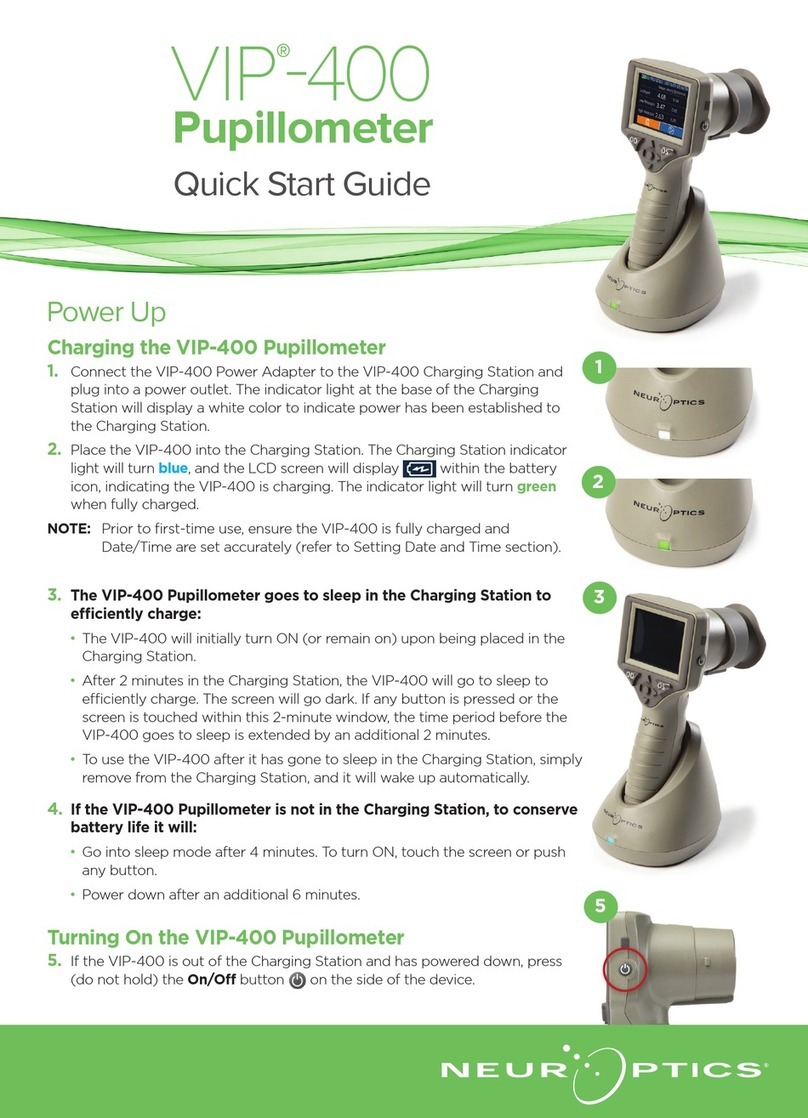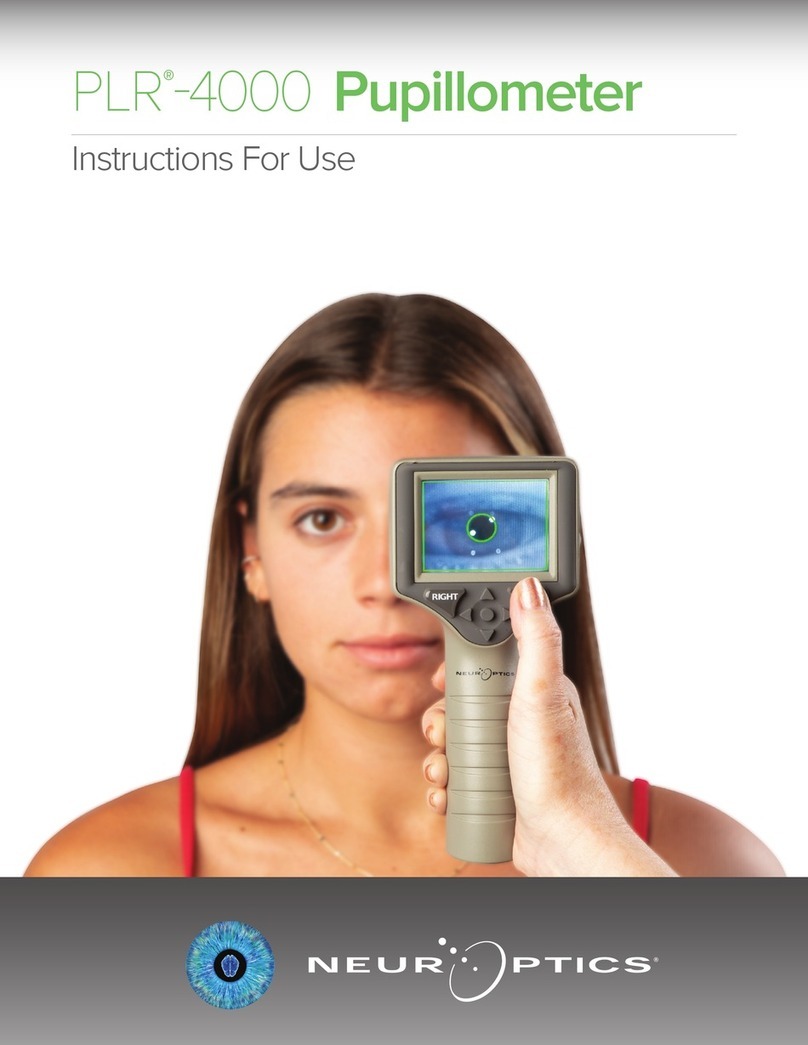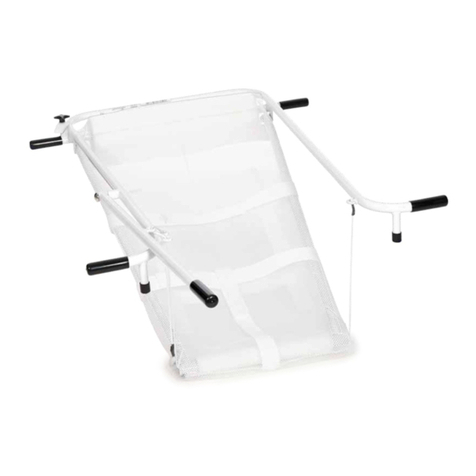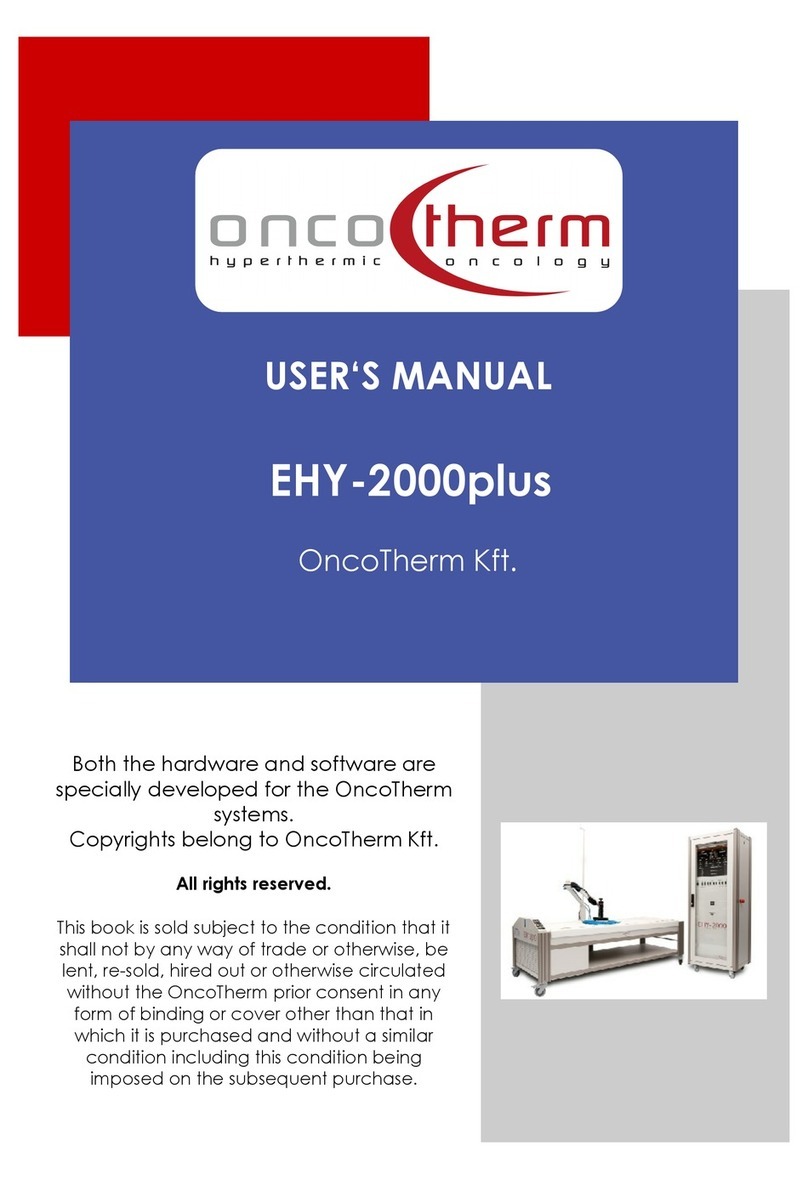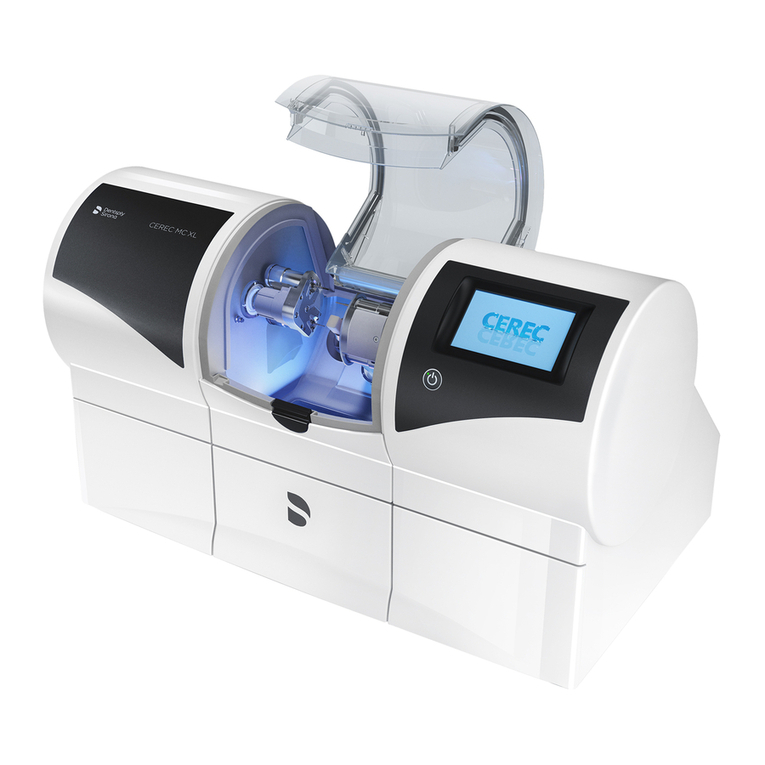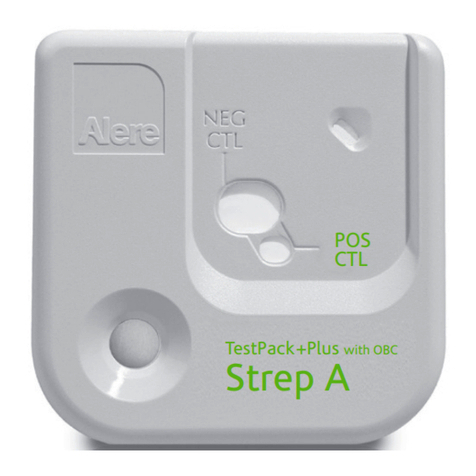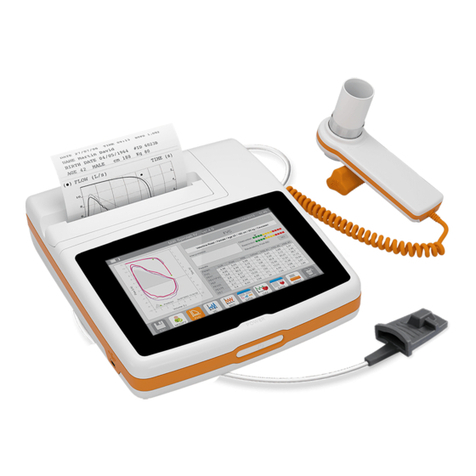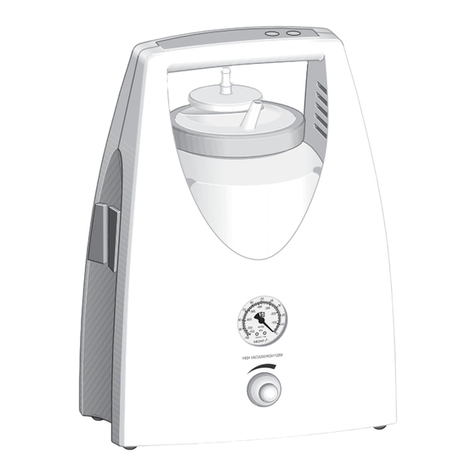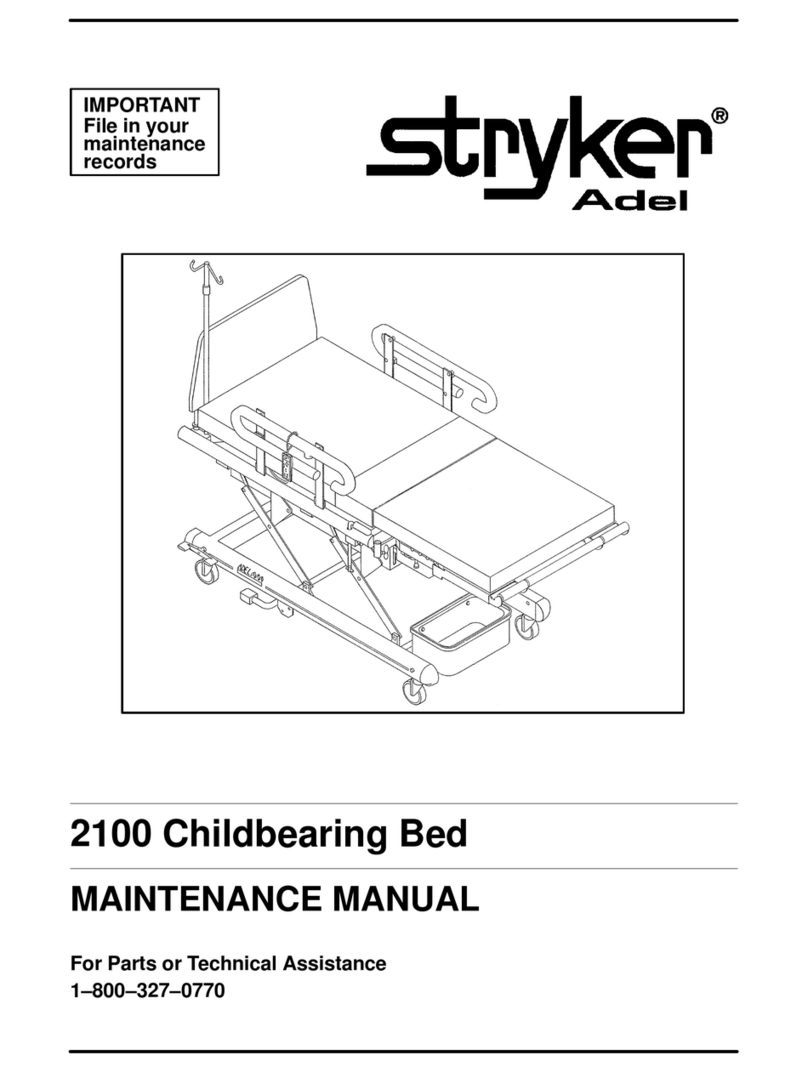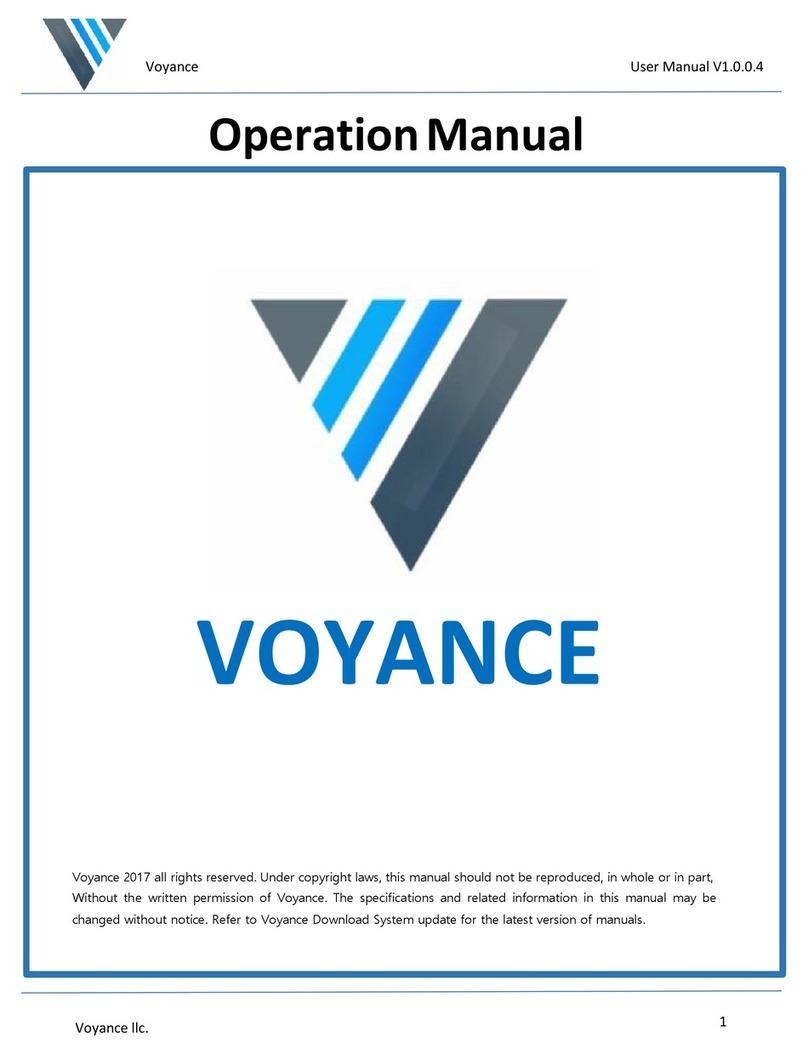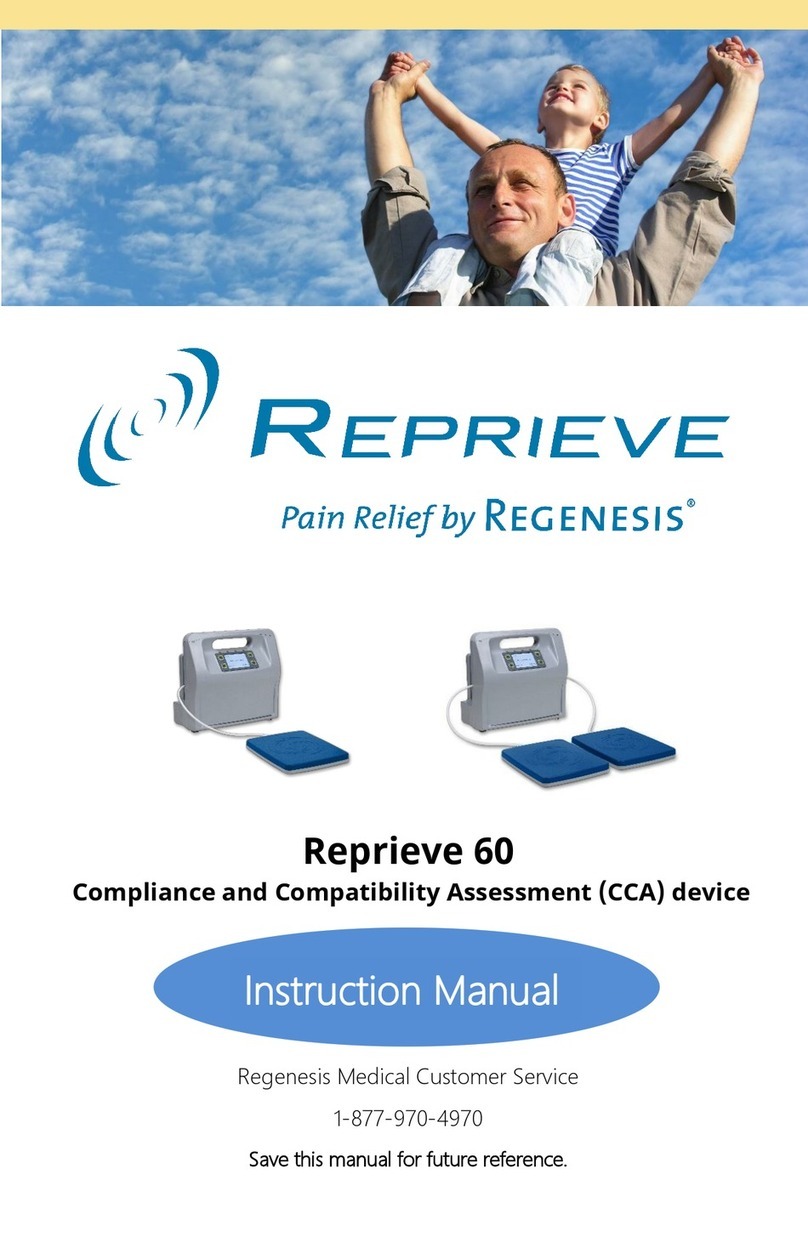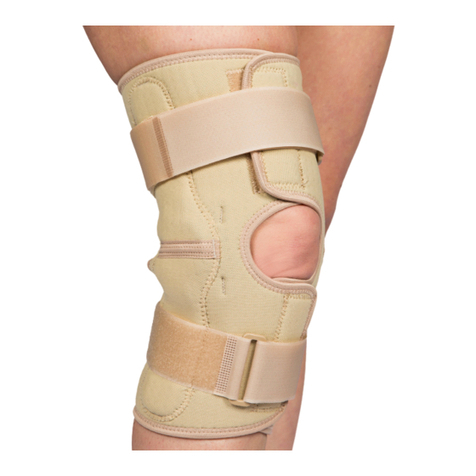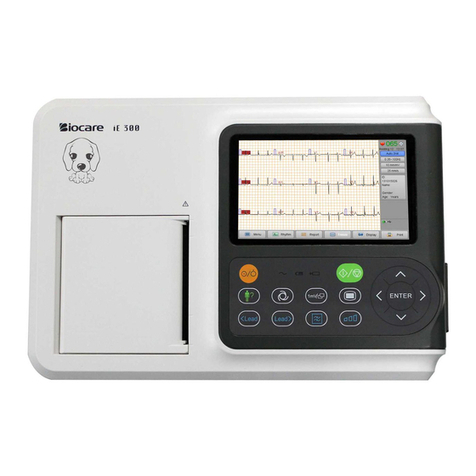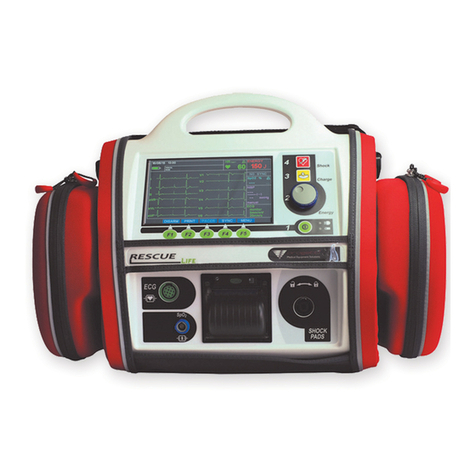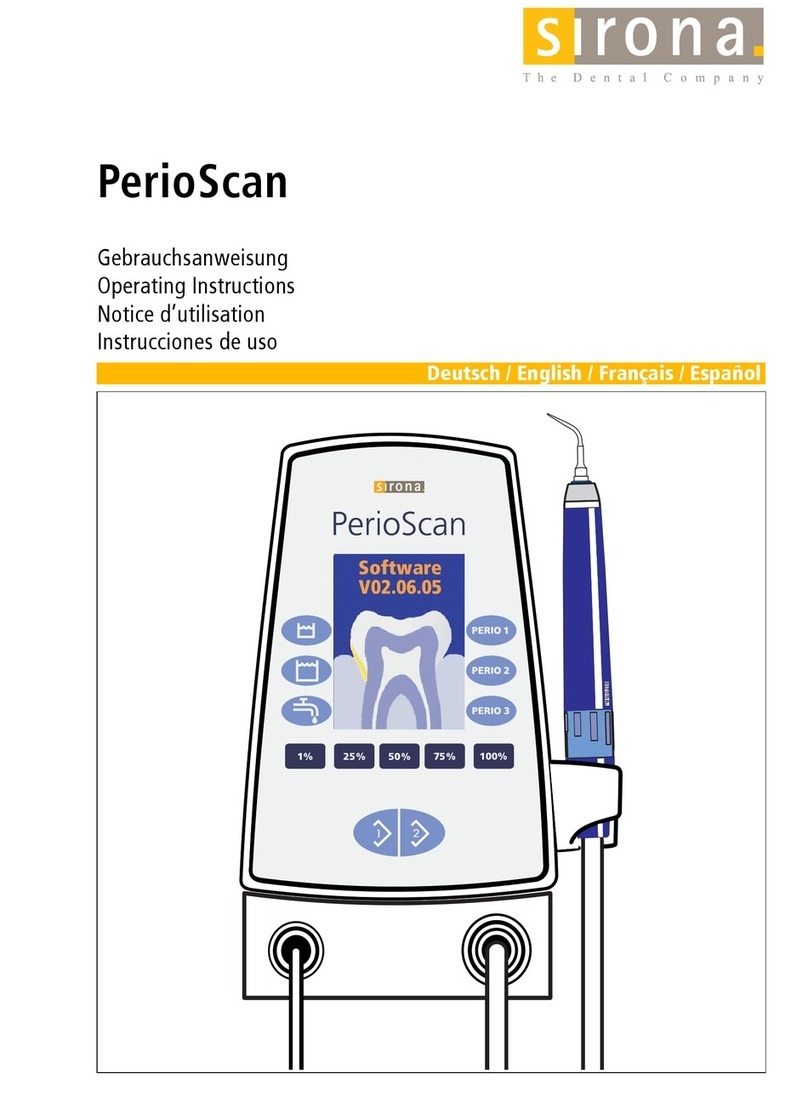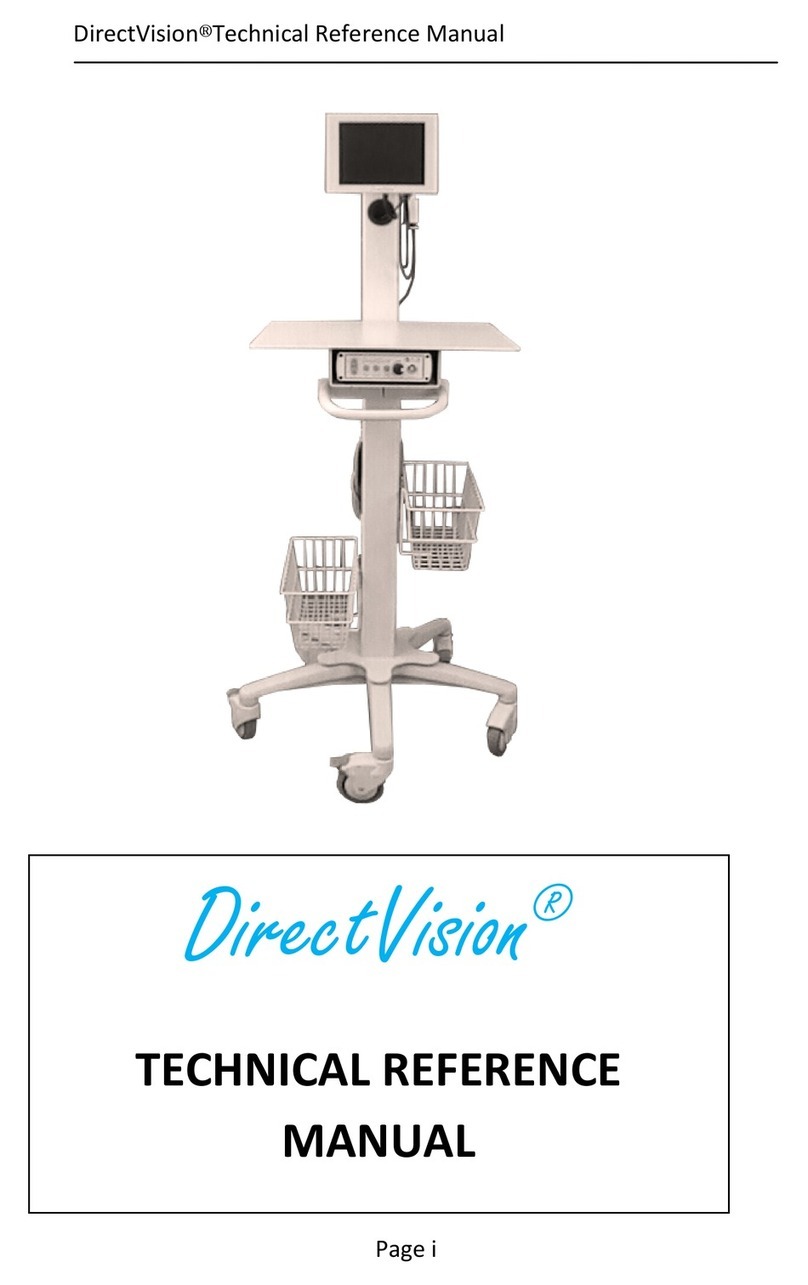NeurOptics NPi-200 User manual

NeurOptics® NPi®-200 Pupillometer System—Instructions for Use © 2018 NeurOptics, Inc. 1
Introduction
The NeurOptics® NPi®-200 Pupillometer offers clinicians quantitative infrared
technology to objectively and accurately measure and trend pupil size and
reactivity in their critically ill patients with neuronal injuries. The NeurOptics
NPi-200 Pupillometer is designed to upload into any hospital electronic medical
record (EMR) system using the SmartGuard® Reader by Omnikey®. The NPi-200
provides a comfortable ergonomic design, easy-to-read touchscreen LCD and
graphics, simple patient identification (ID) number entry and trending capabilities
customized to the clinician preference.
Indications for Use
NPi-200 Pupillometer is a handheld optical scanner which measures pupil size and pupil reactivity in patients requiring
neurological pupil examinations. The results obtained from the Pupillometer scans are used for information only and are
not to be used for clinical diagnostic purposes. The NPi-200 Pupillometer should only be operated by properly trained
clinical personnel, under the direction of a qualified physician.
Contraindications
Avoid use when the orbit structure is damaged, or surrounding soft tissue is edematous or has an open lesion.
Table of Contents
Warnings and Cautions ..................................................... 2
Classification...................................................................... 2
Patents, Copyright and Trademark Notice........................ 2
Getting Started .................................................................. 3
Power Up ........................................................................... 3
Scan the Patient ID ............................................................ 4
Measure Pupils .................................................................. 5
Pupil Measurements - Special Considerations................. 6
Trend for Changes............................................................. 7
Power Off........................................................................... 7
Rebooting the NPi-200 Pupillometer ............................... 7
Troubleshooting................................................................. 7
Cleaning and Maintenance ............................................... 8
Customer Service.............................................................. 9
Ordering Information........................................................................ 9
Appendix A
Pupillary Measurement Parameters..............................10
Appendix B
Technical Specifications ...............................................10
Appendix C
Bluetooth® and Radio Frequency Identification Device
(RFID) Broadcast Range and Frequency .......................11
Appendix D
Pupillometer Display Limits for Electronic Medical Record
(EMR) Flowsheet Integration.......................................................11
Appendix E
International Symbol Definition................................................12
NPi®-200
Pupillometer
Instructions for Use
NPi®-200 Pupillometer
NeurOptics® NPI®-200 Pupillometer System—Instructions for Use © 2022 NeurOptics, Inc.

NeurOptics® NPi®-200 Pupillometer System—Instructions for Use © 2018 NeurOptics, Inc. 2
Warnings and Cautions
Warnings
Warnings and Cautions appear throughout this manual where
they are relevant. The Warnings and Cautions listed here apply
generally any time you operate the device.
• Use of the Pupillometer - The Pupillometer is intended for
use by trained clinical personnel, under the direction of a
qualified physician.
• If a problem is recognized while operating the device, the
device must be removed from use and referred to qualified
personnel for servicing. Using an inoperative device may
result in inaccurate readings.
• Electric shock hazard - Do not open the device or the charging
station. There are no user serviceable parts.
• The battery in the NPi-200 Pupillometer is only replaceable by a
qualified service technician. Contact NeurOptics if you suspect
an inoperable battery.
• Use only the NeurOptics NPi-200 Charging Station for
charging the Pupillometer.
• Risk of fire or chemical burn - This device and its components
may present a risk of fire or chemical burn if mistreated. Do not
disassemble, expose to heat above 100°C, incinerate, or
dispose of in fire.
Cautions
The following cautions apply when cleaning the device or when
sterilizing device accessories.
• The internal components of the Pupillometer are not compatible
with sterilization techniques, such as ETO, Steam Sterilization,
Heat Sterilization and Gamma.
• DO NOT submerge the device or pour cleaning liquids over or
into the device.
• DO NOT use acetone to clean any surface of the Pupillometer
or Charging Station.
Electromechanical Compatibility (EMC) Notice
This device generates, uses, and can radiate radio frequency
energy. If not set up and used in accordance with the
instructions in this manual, electromagnetic interference
may result. The equipment has been tested and found to
comply with the limits set forth in EN60601-1-2 for Medical
Products. These limits provide reasonable protection against
electromagnetic interference when operated in the intended
use environments (e.g. hospitals, research laboratories).
Magnetic Resonance Imaging (MRI) Notice
This device contains components whose operation can be
affected by intense electromagnetic fields. Do not operate the
device in an MRI environment or in the vicinity of high-frequency
surgical diathermy equipment, defibrillators, or short-wave therapy
equipment. Electromagnetic interference could disrupt the
operation of the device.
Bluetooth® Notice
Do not attempt to pair the NPi-200 Pupillometer and the
SmartGuard® using the Barcode Scanner by Socket® while
simultaneously using another barcode scanner in close
proximity.
Classification
Type of Equipment: Medical Equipment, Class 1 886.1700
Trade name: NeurOptics® NPi®-200 Pupillometer
Manufactured by:
NeurOptics, Inc.
9223 Research Drive
Irvine, CA 92618 |USA
p: 949.250.9792
Toll Free North America: 866.99.PUPIL
info@NeurOptics.com
NeurOptics.com
Patents, Copyright and Trademark Notice
Copyright © 2022 NeurOptics, California.
This work is protected under Title 17 of the U.S. Code and is
the sole property of NeurOptics, Inc. (the Company). No part
of this document may be copied or otherwise reproduced, or
stored in any electronic information retrieval system, except
as specifically permitted under U.S. Copyright law, without the
prior written consent of the Company.
Pupillometers:
Pat. No. 6116736
Pat. No. 6260968
Pat. No. 6820979
Pat. No. 7147327
Pat. No. 7670002
Pat. No. 8235526
Pat. No. 8393734
Pat. No. 7967442
Pat. No. 8534840
Pat. No. 9198570
Canadian Pat. No. 2368232
Other Patents Pending
SmartGuard:
Pat. No. 7216985
Pat. No. 7488074
Pat. No. 7901079
Other Patents Pending
Federal Communications Commission Compliance
This device complies with Part 15 of the Federal
Communications Commission (FCC) Rules. Operation is
subject to the following two conditions: (1) this device may not
cause harmful interference, and (2) this device must accept
any interference received, including interference which may
cause undesired operation.
NeurOptics® NPI®-200 Pupillometer System—Instructions for Use © 2022 NeurOptics, Inc.

NeurOptics® NPi®-200 Pupillometer System—Instructions for Use © 2018 NeurOptics, Inc. 3
Turning On the NPi-200
When not in use, the NPi-200 will remain powered ON when seated in the NPi-200
Charging Station.
If the NPi-200 is not in the Charging Station, to conserve battery life the Pupillometer will:
• Go into sleep mode after 5 minutes. To turn ON, touch the screen, push any button, or
place in the Charging Station.
• Power down after 30 minutes.
To Turn On the NPi-200
• Press and hold the button (red circle).
To Get to the Home Screen
• Press LEFT or RIGHT button (green circles).
Getting Started
Safety Information
• Please review the following safety information prior to operating the device.
• Please read the Operating Instructions fully before attempting to use the Pupillometer. Attempting to operate
the device without fully understanding its features and functions may result in unsafe operating conditions
and/or inaccurate results.
• If you have a question regarding the installation, set-up,
operation, or maintenance of the device, please
contact NeurOptics.
Unpacking the Pupillometer
The NeurOptics NPi-200 Pupillometer is packaged
with the following components (Ex. 1):
• NPi-200 Pupillometer
• NPi-200 Charging Station
• NPi-200 Power Adapter and Plug
• NeurOptics Lens Cloth
• NPi-200 Pupillometer Quick Start Guide
•NPi-200 Pupillometer Cleaning and Maintenance Instructions
Power Up
Initial Set-up
Connect the NPi-200 Power Adapter and Plug to the NPi-200 Charging Station
and plug into a power outlet. The green light at the base of the Charging Station
will indicate power has been established (Ex. 2).
Place the NPi-200 into its Charging Station. After powering on, the touchscreen will
display a blue battery icon indicating the NPi-200 is charging. The battery icon will turn
green when fully charged (Ex. 3).
To modify the date and time, from the main screen, select the
Settings icon and then select Set Date and Set Time
(Ex. 4A & 4B). Follow the prompts to input the proper date and
time using 24 hour time configuration and select Accept.
Ex. 1
Ex. 2
Ex. 3
Ex. 4A Ex. 4B
Ex. 5
NeurOptics® NPI®-200 Pupillometer System—Instructions for Use © 2022 NeurOptics, Inc.

NeurOptics® NPi®-200 Pupillometer System—Instructions for Use © 2018 NeurOptics, Inc. 4
Scan the Patient ID
Open a new SmartGuard® (Ex. 6).
Gently squeeze the SmartGuard side tabs to position onto the NPi-200.
There will be an audible click when the SmartGuard is properly
positioned (Ex. 7).
For the first patient use, in order to properly input the patient ID into the SmartGuard,
select either Barcode Scanner or Manual ID to indicate the patient ID entry method
used (Ex. 8).
Pairing the NPi-200 to the Barcode Scanner
Connect the Barcode Scanner and Charging Cradle to the power
supply and plug into a power outlet. Turn on the Barcode Scanner until an audible
beep is heard and a blue light on the device flashes. Position the Barcode Scanner
next to the NPi-200.
On the NPi-200, select Barcode Scanner. The NPi-200 will
display
“Connecting...”
on the touchscreen (Ex. 9). Once
successfully paired, the touchscreen will prompt when the
device is ready to scan the patient ID barcode (Ex. 10).
The patient ID will now appear on the NPi-200 touchscreen. Confirm the
patient information is correct and select Accept (Ex. 11).
The NPi-200 will display the patient ID number and read
“Ready to scan”
(Ex. 12).
Manual Entry of the Patient ID
Press Manual Entry. Using the touchscreen, press the Patient ID.
Select Shift to toggle from alpha to numeric (Ex. 13 & 14) as
required. When the patient ID number has been manually
entered, check for accuracy and press Enter.
Ex. 7
Ex. 8
Ex. 14
Ex. 12
Ex. 9
Ex. 10
Ex. 11
Ex. 13
NeurOptics® NPI®-200 Pupillometer System—Instructions for Use © 2022 NeurOptics, Inc.
Ex. 6

NeurOptics® NPi®-200 Pupillometer System—Instructions for Use © 2018 NeurOptics, Inc. 5
Measure Pupils
Position the NPi-200 with SmartGuard at a right angle
to the patient’s axis of vision, minimizing any tilting of
the device (Ex. 15).
Press and hold either the RIGHT or LEFT button until the eye is centered on the
touchscreen and the display shows a green circle around the pupil (Ex. 16). Once the
green circle appears, release the button, holding the NPi-200 in place for approximately
three seconds until the result screen is displayed.
Repeat the scan procedure for the patient’s other eye
to complete the bilateral pupil exam (Ex. 17).
When the bilateral pupil exam is complete, the NPi-200
measurement results will be displayed in green for the
Right eye and in yellow for the Left eye (Ex. 18).
Using the touchscreen or keypad, select page 1 (1/2) or 2 (2/2)
to display the results of the pupil measurement parameters
and pupillary light reflex waveform (Ex. 19).
Video Replay
From the Results screen, select the Video icon to view the video playback
of the reading (Ex. 20). Only the last measurement’s video can be played back.
Once the device has been turned off, the last video is not accessible.
Disabling SmartGuard
The SmartGuard is designed for single patient use. To assist
facility compliance with HIPAA guidelines, the patient data
stored on each SmartGuard can be disabled once pupil exams
are no longer required. To permanently disable the patient data
on the SmartGuard, in the Settings menu press Disable SG
and follow the prompts (Ex. 21A & 21B).
Ex. 17
Ex. 19
Ex. 16
Ex. 18
Ex. 20
Ex. 21A Ex. 21B
NeurOptics® NPI®-200 Pupillometer System—Instructions for Use © 2022 NeurOptics, Inc.
Ex. 15

NeurOptics® NPi®-200 Pupillometer System—Instructions for Use © 2018 NeurOptics, Inc. 6
Pupil Measurements – Special Considerations
Blinking During Measurement
If the measurement was affected by a tracking problem (e.g., blinks), then measurement
results are all displayed in red font on the results screen and NPi is reported as “Rescan”.
In this case, the measurement results are not valid and should not be relied upon and
the measurement should be repeated (Ex. 22).
Non-Responsive Pupil
In case of a non-responsive pupil, before reporting the results on the LCD screen,
the measurement is automatically repeated for confirmation. The operator is simply
asked to wait a few more seconds before removing the device (Ex. 23). If the operator
believes a second confirmatory measurement is not necessary, then press the RIGHT
or LEFT button to skip.
Small “Pinpoint” Pupil Measurement
Pupillometer Resolution Threshold: Pupil Size
The NPi-200 Pupillometer measurement threshold for measuring pupil size is 1.0 mm, which means the
pupillometer can measure pupils as small as 1.0 mm in diameter. If the pupil size is < 1.0 mm, the pupillometer
will not detect the pupil, and it will not initiate a measurement.
Pupillometer Resolution Threshold: Change in Pupil Size
The NPi-200 Pupillometer’s minimum measurement threshold for detecting a change in pupil size is 0.03 mm
(30 microns). In the event a change in pupil size is < 0.03 mm, the pupillometer will not be able to measure a
change in pupil size, and it will display an NPi of 0.
The Neurological Pupil index™(NPi®) Pupil Reactivity Assessment Scale
Measured Value* Assessment
3.0 – 4.9 Normal/“Brisk”
< 3.0 Abnormal/“Sluggish”
0Non-Reactive, Immeasurable, or Atypical Response
* A dierence in NPi between Right and Left pupils of ≥ 0.7 may also be considered an abnormal pupil reading
* Per the Neurological Pupil index (NPi) algorithm
NPi Measurement of “0”
The NPi-200 Pupillometer will measure an NPi of 0 in the following clinical assessment scenarios:
• Non-Reactive response= Non-reactive pupillary response; no pupillary light reflex (PLR) waveform
•Immeasurable response= Change in pupil size < 0.03 mm (30 microns)
• Atypical response= An abnormal pupillary light reflex (PLR) waveform
Ex. 22
Ex. 23
NeurOptics® NPI®-200 Pupillometer System—Instructions for Use © 2022 NeurOptics, Inc.

NeurOptics® NPi®-200 Pupillometer System—Instructions for Use © 2018 NeurOptics, Inc. 7
Power Off
To turn the NPi-200 off, select the from the main screen and confirm Yes.
Rebooting the NPi-200 Pupillometer
As with any electronic device, the NPi-200 Pupillometer may occasionally require a System Reboot. To reboot the
NPi-200 Pupillometer, simply press and hold the button on the device until the Pupillometer powers ON.
Troubleshooting
Trend for Changes
To visualize the parameter trend display, use either the keypad
or the touchscreen to select the Chart icon from the
main screen of the NPi-200. Select the DOWN arrow on
the keypad to view a trend display of the patient’s NPi and Size
measurements (Ex. 24 & 25).
Choose desired parameters to trend
To trend additional parameters, select Trending Variables from the Settings menu,
and choose the desired parameters to trend (Ex. 26).
Issue Possible Reason Solution
1. Device will not turn on Using incorrect power supply Use only power supply provided with
Pupillometer. Check label on power supply
Power cord is not fully plugged into
the wall or the charging station
Check connections
Battery completely discharged Charge the battery by positioning the Pupillometer
into the charger
2. Pupil measurement will not
initiate after release of the
RIGHT or LEFT key
Too much blinking Gently hold patient’s eye open with your finger
during measurement
Device not held correctly Hold device at a 90-degree angle to patient’s
face. Make sure patient’s eye is centered on
the screen
3. “Rescan” displayed
following measurement
Pupillometer is moved from
position prior to completion of the
measurement
Repeat the scan and maintain proper position
of the Pupillometer until the measurement is
completed and pupillary measurements are
displayed.
Patient blinked during
measurement
Hold the patient’s eyelid open and repeat the
scan.
NeurOptics® NPI®-200 Pupillometer System—Instructions for Use © 2022 NeurOptics, Inc.
Ex. 25
Ex. 26
Ex. 24

NeurOptics® NPi®-200 Pupillometer System—Instructions for Use © 2018 NeurOptics, Inc. 8
Cleaning and Maintenance
ALWAYS handle the NPi-200 Pupillometer and NPi-200 Charging Station with care because sensitive metal, glass,
plastic and electronic components are contained inside. The NPi-200 Pupillometer and NPi-200 Charging Station can
be damaged if dropped, or if they come in contact with liquid.
The NPi-200 Pupillometer and NPi-200 Charging Station do not require any regularly scheduled maintenance. If the
NPi-200 Pupillometer and NPi-200 Charging Station are not working properly, or are believed to have been damaged,
immediately contact NeurOptics Customer Service at Toll Free North America: 866.99.PUPIL (866-997-8745),
international: +1-949-250-9792, or email: Info@NeurOptics.com.
Cleaning the NPi-200 Pupillometer and NPi-200 Charging Station
Isopropyl alcohol (IPA)-based cleaning solutions, in formula concentrations up to 70% IPA, are recommended for
use in cleaning the NPi-200 Pupillometer and NPi-200 Charging Station. Do not use chemicals that can damage the
pupillometer and charging station surface. Some chemicals can weaken or damage plastic parts and may cause
instruments to not operate as intended. Use all cleaning products per manufacturer’s instructions, being careful to
squeeze out excess liquid prior to wiping the pupillometer and charging station and do not use an oversaturated cloth.
Wipe all exposed surfaces. Follow the cleaner’s manufacturer instructions as to the time required to leave the solution
on the device surface.
• DO NOT allow any cleaner more than 70% IPA to contact the gold connector blades located on the
bottom of the NPi-200 Pupillometer handle or the gold connector pins located in the base of the NPi-200
Charging Station.
• DO NOT use an oversaturated cloth. Be sure to squeeze out excess liquid prior to wiping the NPi-200
Pupillometer or the NPi-200 Charging Station.
• DO NOT allow the cleaner to collect on the instrument.
• DO NOT use any hard, abrasive or pointed objects to clean any part of the NPi-200 Pupillometer or NPi-200
Charging Station.
• DO NOT immerse the NPi-200 Pupillometer or the NPi-200 Charging Station in liquid, or attempt to sterilize the
product, as damage to the electronic and optical componentry could occur.
Drying and Inspection Following Cleaning
Confirm the NPi-200 Pupillometer is thoroughly dry before placing in the NPi-200 Charging Station to charge. Once
thoroughly dry, place the NPi-200 Pupillometer into the NPi-200 Charging Station and plug in the NPi-200 Power
Adapter and Plug to the back of the charging station to power ON.
• DO NOT place the NPi-200 Pupillometer into the NPi-200 Charging Station until all components are
completely dry.
• DO NOT reconnect the NPi-200 Power Adapter and Plug to the NPi-200 Charging Station until all components
are completely dry.
NeurOptics® NPI®-200 Pupillometer System—Instructions for Use © 2022 NeurOptics, Inc.

NeurOptics® NPi®-200 Pupillometer System—Instructions for Use © 2018 NeurOptics, Inc. 9
If products containing sodium hypochlorite (bleach) are used to clean the gold connector blades located on the bottom
of the NPi-200 Pupillometer and the gold connector pins located in the base of the NPi-200 Charging Station, the
cleaning process should be followed by a second cleaning using up to 70% IPA solution to ensure that all residue is
completely removed from the device in order to minimize damage to the gold connector pins and blades.
Cleaning Considerations: Pupillometer Liquid Crystal Display (LCD)
For best protection of the liquid crystal display (LCD), use a clean, soft, lint-free cloth and up to 70% IPA cleaning
solution to clean the pupillometer optics.
In instances where there is concern of exposure to highly resistant bacteria, viruses, fungi or spores (ie: Clostridium
difficile, or “C. diff”), we understand that hospital protocols may require use of cleaning solutions containing sodium
hypochlorite (bleach) when cleaning equipment. If products containing sodium hypochlorite (bleach) are used to clean
the LCD of the NPi-200 Pupillometer, the cleaning process should be followed by a second cleaning solution with up to
70% IPA solution to ensure that all bleach residue is completely removed from the LCD using a clean, soft, lint-free cloth.
• DO NOT use products containing sodium hypochlorite (bleach) to clean the gold connector blades located
on the bottom of the NPi-200 Pupillometer handle, and the gold connector pins located in the base of the
NPi-200 Charging Station.
Figure 1- Gold Connector Blades Figure 2- Gold Connector Pins
Gold
Connector
Blades
Gold
Connector
Pins
NPi®-200 Pupillometer NPi®-200 Charging Station
Cleaning and Maintenance (cont.)
Cleaning Considerations: Gold Connector Pins and Blades
In instances where there is concern of exposure to highly resistant bacteria, viruses, fungi or spores (ie: Clostridium
difficile, or “C. diff”), hospital protocols may require use of cleaning solutions containing sodium hypochlorite (bleach)
when cleaning equipment. Please be aware solutions containing sodium hypochlorite (bleach) will corrode the gold
connector blades located on the bottom of the NPi-200 Pupillometer handle (Figure 1), and the gold connector pins
located in the base of the NPi-200 Charging Station (Figure 2).
Customer Service
For technical support, or if you have a question regarding your product or order, please contact NeurOptics Customer
Service at Toll Free North America: 866.99.PUPIL (866-997-8745), international: +1-949-250-9792, or email:
Info@NeurOptics.com.
Ordering Information
NPi-200 NPi®-200 Pupillometer
SG-200 SmartGuard®
BCS-CC-04-(1D or 2D) Barcode Scanner by Socket®
SGR-01 SmartGuard® Reader (Please contact Customer Service to determine the specic
reader compatible with the hospital requirements)
NeurOptics® NPI®-200 Pupillometer System—Instructions for Use © 2022 NeurOptics, Inc.

Appendix A—Pupillary Measurement Parameters
Parameter Description
NPi®= Neurological Pupil
index™
Numerical expression of pupil reactivity. Please refer to the Neurological Pupil
index™ (NPi®) Pupil Assessment Scale (Page 6) for additional information.
Size = Maximum Diameter Maximum pupil size before constriction
MIN = Minimum Diameter Pupil diameter at peak constriction
CH = % Change % of change (Size-MIN) / Size as a %
LAT = Latency of constriction Time of onset of constriction following initiation of the light stimulus
CV = Constriction Velocity Average of how fast the pupil diameter is constricting measured in millimeters per second
MCV = Maximum
Constriction Velocity
Maximum velocity of pupil constriction of the pupil diameter responding to the
ash of light measured in millimeters per second
DV = Dilation Velocity
The average pupillary velocity when, after having reached the peak of constriction,
the pupil tends to recover and to dilate back to the initial resting size, measured in
millimeters per second
Appendix B—Technical Specifications
Parameter Description
Pupillometer Measurement
Detection Threshold
Pupil diameter (minimum) 1.00 mm
Pupil diameter (maximum) 10.00 mm
Change in Size 0.03 mm (30 microns)
Size Accuracy +/- 0.03 mm (30 microns)
Degree of protection
against electric shock Pupillometer SmartGuard-Type BF Applied Part provided protection
Classification of the equipment
against ingress of liquids Ordinary equipment
Degree of safety of application
in the presence of flammable
anesthetic mixture with air or
with oxygen or nitrous oxide
The equipment is not an AP or APG category equipment
Mode of Operation On Demand battery operation
Power Supply Input: 100-240 VAC +/- 8%
Output: 6V, 2.8 Amps
Battery 3.6 V 11.70 Wh 3350 mAh/hour Li: Ion Cell
Operating Environment Temperature Range: 18° C (65° F) to 30° C (86° F)
Relative Humidity: 20% to 70% RH. Non condensing at all times
NeurOptics® NPI®-200 Pupillometer System—Instructions for Use © 2022 NeurOptics, Inc. 10
Customer Service (cont.)
Returned Goods Policy
Products must be returned in unopened packages, with manufacturer’s seals intact, to be accepted for replacement
or credit, unless returned due to a complaint of product defect or mislabeling. Determination of a product defect or
mislabeling will be made by NeurOptics, which determination will be final. Products will not be accepted for replacement
or credit if they have been in the possession of the customer for more than 30 days.

Appendix C—Bluetooth® and Radio Frequency Identification Device (RFID)
Broadcast Range and Frequency
Broadcast Function Range Frequency
Bluetooth Barcode Scanner to/from
NPi-200 Pupillometer
Up to 100 yards depending on environment 2.45 GHz
RFID memory card in SmartGuard to/from
NPi-200 Pupillometer
Up to 2 centimeters 13.56 MHz
RFID memory card in SmartGuard to/from
SmartGuard Reader
Up to 2 centimeters 13.56 MHz
© 2022 NeurOptics, Inc. NeurOptics, NPi, Neurological Pupil index, SmartGuard, and SmartGuard Reader are all trademarks of NeurOptics, Inc. Bluetooth is a registered
trademark of Bluetooth SIG, Inc. Socket is a registered trademark of Socket Mobile, Inc., and Omnikey is a registered trademark of HID Global Corporation/ASSA ABLOY AB.
All rights reserved.
Appendix D—Pupillometer Display Limits for Electronic Medical Record (EMR)
Flowsheet Integration
The following low and high display limits are included to inform hospital staff of the specific parameter display limits for
consideration in the development of neurological parameter flow sheets.
Parameter LOW HIGH
NPi 0.0 4.9
Size 1.00 mm 10.00 mm
MIN 1.00 mm 10.00 mm
CH 0% 50%
CV 0.00 mm/s 6.00 mm/s
MCV 0.00 mm/s 6.00 mm/s
LAT 0.00 sec 0.50 sec
DV 0.00 mm/s 6.00 mm/s
NeurOptics® NPI®-200 Pupillometer System—Instructions for Use © 2022 NeurOptics, Inc. 11
Transportation and
storage environment
Temperature Range: 0° C (32° F) to 75° C (167° F)
Relative Humidity: 10% to 95% RH. Non-condensing at all times
Dimensions With SmartGuard = 7.5” H, 3.5” W, 4.5” D
Without SmartGuard = 7.5” H, 3.5” W, 3.5” D
Weight 320 grams +/- 10 grams
Classification Class 1 LED product per IEC 62471
Appendix B—Technical Specifications (cont.)

NPi 200 IFU Appendix E- International Symbol Definition
Source/ComplianceSymbol Title of Symbol Description of Symbol
Standard: ISO 15223-1
Symbol Reference No: 5.4.4 Caution
Indicates that caution is necessary
when operating the device or
control close to where the
symbol
is placed, or that the current
situation needs operator awareness
or operator action in order to avoid
undesirable consequences
Standard: IEC 60601-1,
Table D.1, Symbol 20
Standard: IEC 60417-5333
Type BF applied part To identify a type BF applied part
complying with IEC 60601-1
Standard: IEC 60601-1,
Table D.1, Symbol 19
Standard: IEC 60417-5840
Type B applied part To identify a type B applied part
complying with IEC 60601-1
Standard: IEC 60417-5010 “ON”/ “OFF”
(push-push)
To indicate connection to or
disconnection from the mains, at
least for mains switches or their
positions, and all those cases
where safety is involved
Section 1.1 of Chapter I
of Annex IX to Directive
93/42/EEC.
U.S. 21 CFR 801.5(c.)
Intermittent Use
To indicate use to be Transient
or intermittent with contact to
intact skin with duration less
than 60 minutes
Standard: ISO 15223-1
Symbol Reference No: 5.2.7 Non-sterile.
Indicates a
medical device
that
has not been subjected to a
sterilization process
Standard: ISO 15223-1
Symbol Reference No: 5.1.7 Serial number
Indicates the
manufacturer’s
serial number
so that a specic
medical device
can be identied
Standard: ISO 15223-1
Symbol Reference No: 5.1.6
Indicates the
manufacturer’s
catalogue number
so that the
medical device
can be identied
Catalogue number
Standard: ISO 15223-1
Symbol Reference No: 5.1.5 Batch Code
Indicates the
manufacturer’s
batch code
so that the batch or
lot can be identied.
NeurOptics® NPI®-200 Pupillometer System—Instructions for Use © 2022 NeurOptics, Inc. 12

NPi 200 IFU Appendix E- International Symbol Definition
Standard: BS EN 50419
Article 11(2) of the
European Community
Directive 2002/96/EC
(WEEE)
Recycle: Electronic
Equipment
Identies product that is
subject to the European Union’s
Waste Electrical and Electronic
Equipment (WEEE) 2012/19/EU
Directive for recycling of
electronic equipment. Do not
dispose of this product in
unsorted municipal waste
stream
U.S. 40 CFR 273.2
European Community
Directive Article 21 of
2006/66/EC
Recycle.
Battery contains Lithium.
Dispose of according to local
procedures for products
containing lithium-Ion batteries
and products containing lithium
perchlorate
Standard: ISO 15223-1
Symbol Reference No: 5.1.1
Standard: ISO 15223-1
Symbol Reference No: 5.4.3
Manufacturer
Consult
instructions for
use
or consult electronic
instructions for use
Indicates the
medical device
manufacturer
Indicates the need for the user
to consult the
instructions for use
European Medical Devices
Directive 93/42/EEC of 14
June 1993 (as amended by
Directive 2007/47/EC) as
described in Article 17 of the
Directive
Conformité
Européene or
European Conformity
Indicates manufacturer
declaration that the product
complies with the essential
requirements of the relevant
European health, safety and
environmental protection
legislation
European Medical Devices
Directive 93/42/EEC of 14
June 1993 (as amended by
Directive 2007/47/EC) as
described in Article 17 of
the Directive
Conformité
Européene or
European Conformity
with Identication of
Notied Body
Indicates that the product
complies with the essential
requirements of the relevant
European health, safety and
environmental protection
legislation and that the product
is listed through TUV SUD as the
Notied Body
Standard: ISO 15223-1
Symbol Reference No: 5.1.2
Authorized
representative in the
European Community/
European Union
Indicates the authorized
representative in the
European Community/
European Union
Source/ComplianceSymbol Title of Symbol Description of Symbol
NeurOptics® NPI®-200 Pupillometer System—Instructions for Use © 2022 NeurOptics, Inc.

NPi 200 IFU Appendix E- International Symbol Definition
Standard: ISO 15223-1
Symbol Reference No: 5.3.4 Keep dry
Indicates a
medical device
that
needs to be protected from
moisture
Standard: ISO 15223-1
Symbol Reference No: 5.3.7 Temperature limit
Indicates the temperature limits
to which the
medical device
can
be safely exposed
Standard: ISO 15223-1
Symbol Reference No: 5.3.1
Standard: ISO 15223-1
Symbol Reference No: 5.7.7
Standard: ISO 15223-1
Symbol Reference No: 5.7.10
Fragile, handle with care
Indicates a
medical device
that
can be broken or damaged if not
handled carefully
Medical Device
Unique device identier
Indicates the item is a
medical
device
Indicates a carrier that contains
unique device identier information
Standard: IEC 60601-1-
2:2007, Clause 5.1.1
Standard: IEC 60417-5140
Non-ionizing
electromagnetic radiation
To indicate generally elevated,
potentially hazardous, levels
of non-ionizing radiation, or to
indicate equipment or systems
e.g. in the medical electrical
area that include RF transmitters
or that intentionally apply RF
electromagnetic energy for
diagnosis or treatment
9223 Research Drive
Irvine, CA 92618 |USA
p: 949.250.9792
Toll Free North America: 866.99.PUPIL
info@NeurOptics.com
NeurOptics.com
NPi2 IFU Rev M (HOMA-956RTQ)
Source/ComplianceSymbol Title of Symbol Description of Symbol
Other manuals for NPi-200
2
Table of contents
Other NeurOptics Medical Equipment manuals
